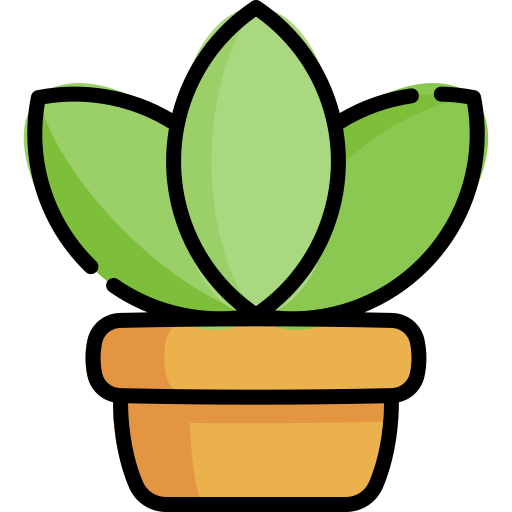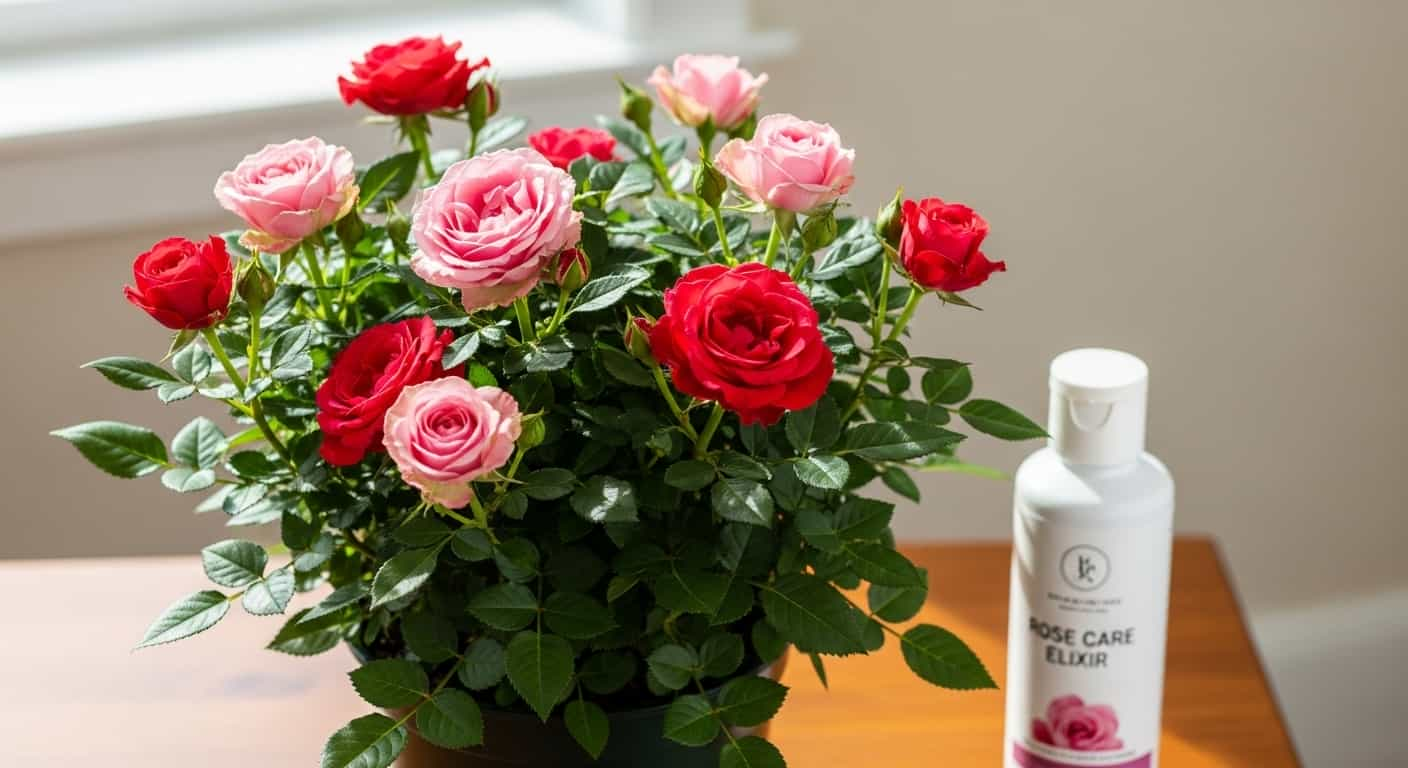Growing roses indoors allows you to enjoy their classic beauty and fragrance up close. You’ve given them the perfect pot, a sunny spot, and a consistent watering schedule. Yet, you might notice the growth is slow, the leaves lack a deep green luster, or the much-anticipated blooms are sparse. The missing piece of the puzzle is often nutrition. Roses are notoriously heavy feeders, and the limited soil in a container can quickly become depleted. Proper fertilizing is the key to unlocking the full potential of your indoor roses.
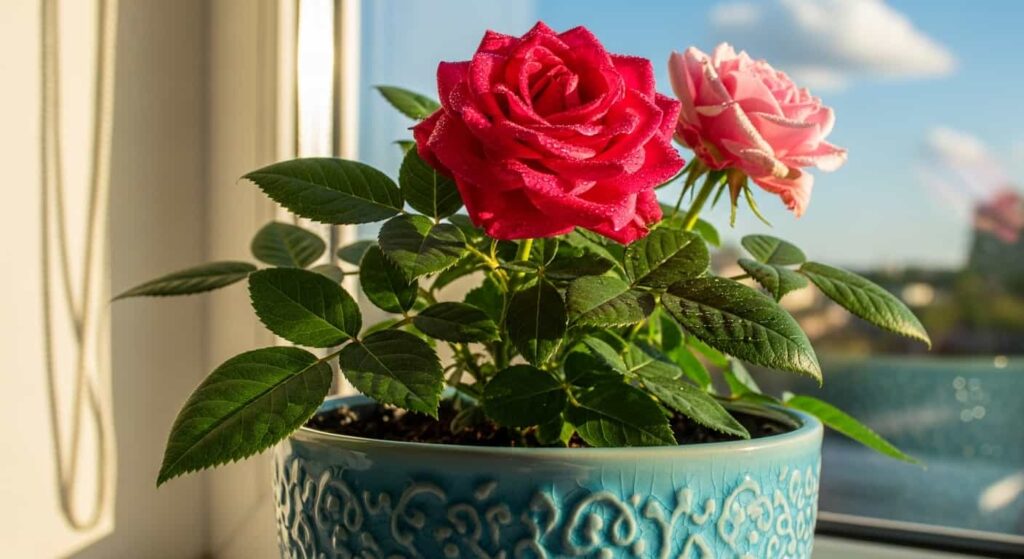
Unlike their garden counterparts that can draw nutrients from a vast expanse of earth, potted roses rely entirely on you to provide the food they need to thrive. Understanding their nutritional needs—what to feed them, when to feed them, and how to do it correctly—is the difference between a plant that merely survives and one that puts on a spectacular floral display.
This guide will walk you through everything you need to know about fertilizing indoor roses. We’ll explore why feeding is so crucial, break down the types of nutrients roses crave, help you choose the best fertilizer, and provide a clear, step-by-step process for feeding your plants safely and effectively.
Why Fertilizing Is Crucial for Indoor Roses
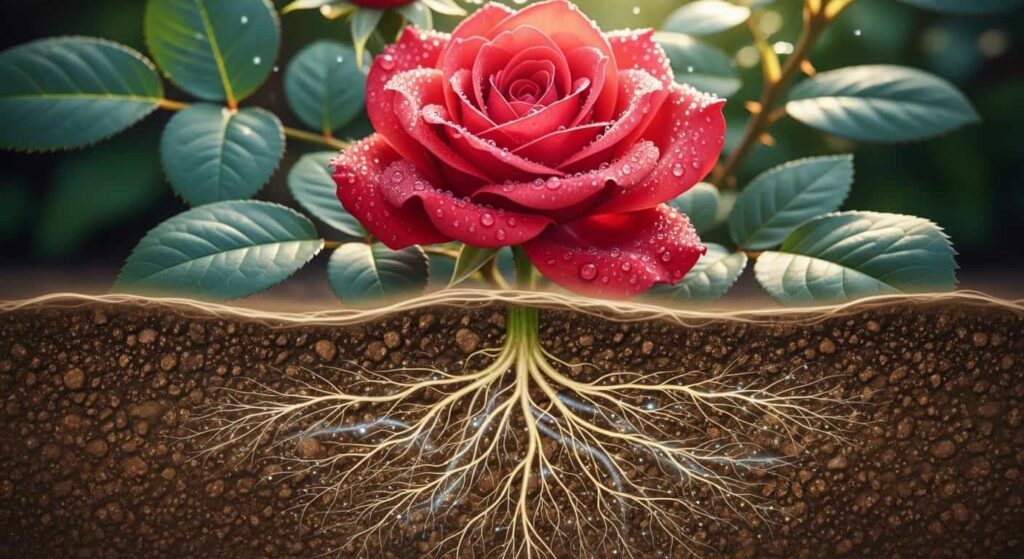
The soil in a pot is a closed ecosystem. Every time you water your plant, some nutrients are washed out through the drainage hole. At the same time, the plant continually absorbs nutrients from the soil to fuel its growth. Over time, this combination of leaching and consumption depletes the available food supply.
1. Fuel for Flowers: Blooming is an incredibly energy-intensive process. To produce a continuous cycle of buds and flowers, a rose needs a steady supply of specific nutrients. Insufficient food is one of the most common reasons an otherwise healthy-looking indoor rose fails to bloom.
2. Lush, Healthy Foliage: Nutrients like nitrogen are essential for producing chlorophyll, the compound that makes leaves green and drives photosynthesis. A well-fed rose will have deep green, glossy leaves. A nutrient-deficient plant may exhibit signs such as yellowing leaves (chlorosis), indicating that it lacks the essential building blocks for healthy foliage.
3. Strong Root Development: Phosphorus is vital for developing a strong, healthy root system. Strong roots are better able to absorb water and nutrients, providing a stable foundation for the entire plant. This is especially important in the confined space of a pot.
4. Overall Vigor and Disease Resistance: A well-nourished plant is like a person with a healthy diet. It has a stronger “immune system” and is better equipped to fend off common pests and fungal diseases like black spot or powdery mildew. A weak, underfed plant is an easy target for problems.
Without a regular fertilizing routine, your indoor rose will eventually exhaust the nutrients in its potting mix, leading to stunted growth, poor health, and a lack of flowers.
Understanding Rose Nutrition: The N-P-K Ratio
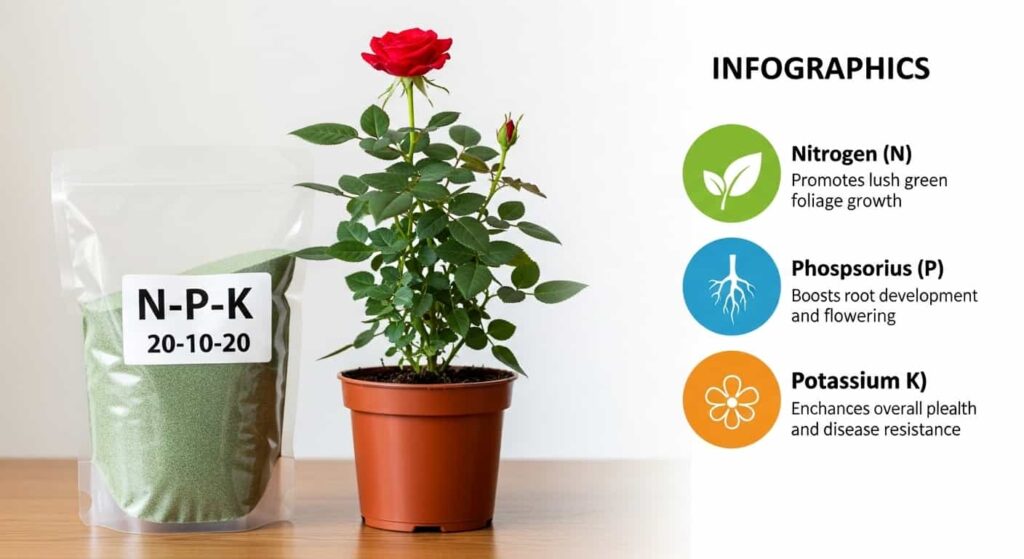
When you look at a bag or bottle of fertilizer, you’ll see three numbers prominently displayed, such as 10-10-10 or 20-5-10. This is the N-P-K ratio, and it represents the percentage of the three primary macronutrients essential for plant growth.
- N – Nitrogen: The first number. Nitrogen is the engine for vegetative growth. It promotes the development of lush, green leaves and strong stems. A lack of nitrogen leads to yellowing leaves and weak growth.
- P – Phosphorus: The second number. Phosphorus is crucial for root development, energy transfer, and, most importantly, for roses, flower production. It helps the plant set buds and produce vibrant blooms.
- K – Potassium: The third number. Potassium is the regulator. It helps the plant manage its overall functions, including water absorption, disease resistance, and stem strength. It contributes to the overall vigor and hardiness of the plant.
For roses, a balanced fertilizer is key. This could be one where all three numbers are equal (like 10-10-10) or one specifically formulated for roses, which might have a slightly different ratio to encourage more blooms without excessive leafy growth.
Beyond these macronutrients, roses also need a range of micronutrients in smaller quantities, such as magnesium, sulfur, iron, manganese, and zinc. High-quality fertilizers, especially those labeled for roses or blooming plants, will typically contain these essential micronutrients as well.
Choosing the Best Fertilizer for Your Indoor Roses
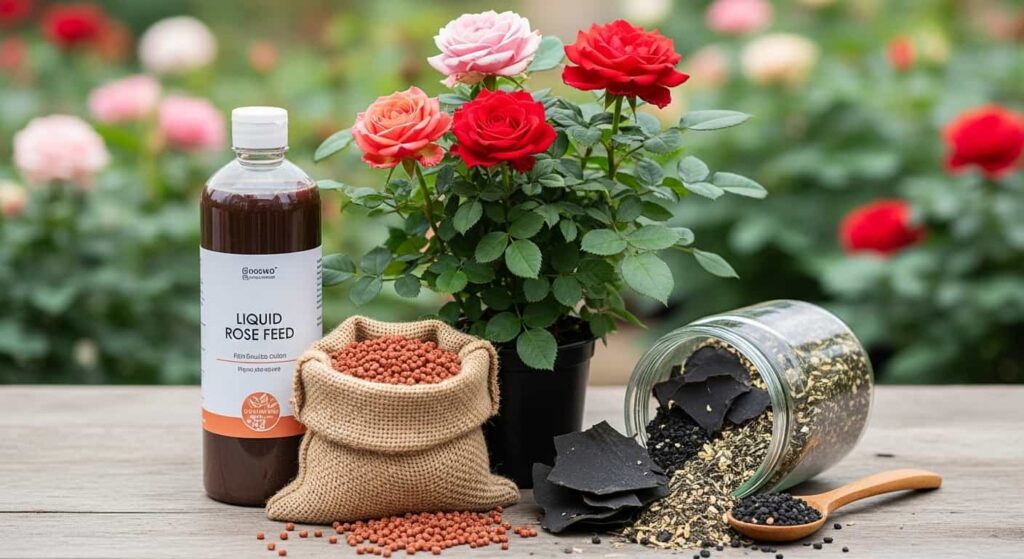
The fertilizer aisle can be overwhelming. Let’s simplify the choices to help you pick the best option for your indoor plants. The main categories are liquid vs. granular and synthetic vs. organic.
Liquid vs. Granular Fertilizers
Liquid Fertilizers: This is the most recommended choice for indoor roses.
- How they work: Liquid fertilizers are mixed with water and applied during your regular watering routine. They provide a quick-acting dose of nutrients that are immediately available for the plant’s roots to absorb.
- Pros: Fast-acting, easy to control the dosage, and less risk of burning roots when used correctly. Excellent for providing a steady, consistent supply of food to container plants.
- Cons: Must be applied more frequently (every 2-4 weeks) as they are washed out of the soil relatively quickly.
Granular Fertilizers (Slow-Release): These come in the form of small pellets or spikes that you mix into or place on top of the soil.
- How they work: Each time you water, the granules slowly break down, releasing a small amount of fertilizer into the soil over a period of months.
- Pros: Convenient and require less frequent application (often only once every 2-3 months).
- Cons: It’s harder to control the release of nutrients, which can sometimes lead to an inconsistent supply. There is a slightly higher risk of concentrating fertilizer in one spot and burning roots if not applied evenly. They are generally better suited for outdoor gardens.
For the precise control needed with indoor potted roses, liquid fertilizers are the superior choice.
Synthetic vs. Organic Fertilizers
Synthetic Fertilizers: These are man-made and manufactured from mineral salts. They are formulated to provide a precise and concentrated dose of nutrients.
- Pros: Nutrients are immediately available to the plant. The N-P-K ratios are exact and reliable. They are often less expensive.
- Cons: They do not improve the soil structure. Overuse can lead to a buildup of mineral salts in the soil and can burn plant roots if not diluted properly.
Organic Fertilizers: These are derived from natural sources like fish emulsion, seaweed (kelp), worm castings, or compost tea.
- Pros: They release nutrients more slowly and gently, reducing the risk of fertilizer burn. They also improve the soil’s structure and support beneficial microbial life.
- Cons: Can sometimes have a noticeable odor (like fish emulsion). Nutrient concentrations can be less precise, and they may act more slowly than synthetic options.
The Best Approach: Many gardeners find success using a combination. A high-quality, balanced synthetic liquid fertilizer can be your primary food source, while occasionally supplementing with an organic option like liquid kelp can provide beneficial micronutrients and support soil health.
The Fertilizing Schedule: When and How Often
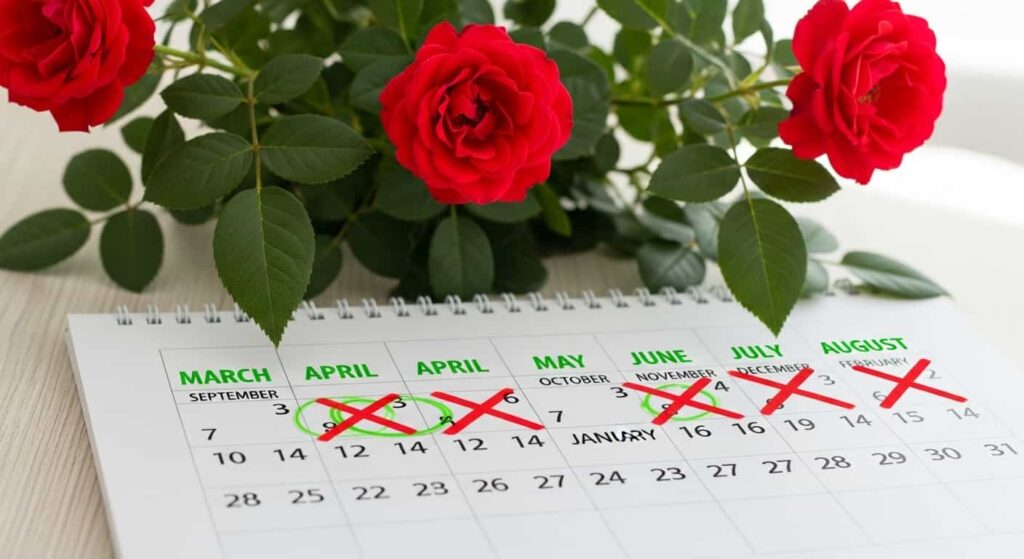
Timing is everything. Fertilizing at the wrong time can be ineffective or even harmful.
The Growing Season: Spring and Summer
This is when your rose is actively growing, producing new leaves, stems, and flowers. It needs a regular supply of food.
- Frequency: Fertilize your indoor rose every 2 to 4 weeks with a diluted liquid fertilizer.
- When to start: Begin fertilizing in the spring as soon as you see signs of new growth, such as new leaves or stems emerging.
- When to stop: Continue this routine throughout the summer months.
The Dormant Period: Fall and Winter
As the days get shorter and the light becomes less intense, your rose will naturally slow its growth. It enters a semi-dormant or resting phase.
- Frequency: Stop fertilizing completely during the fall and winter.
- Why? Feeding a plant when it is not actively growing forces weak, leggy growth and can lead to a buildup of salts in the soil, which can damage the roots.
- When to stop: Taper off your fertilizing schedule in early fall. Your last feeding should be about 6-8 weeks before you expect growth to halt for the winter.
Important Exceptions: If you are growing your rose under powerful grow lights for 14-16 hours a day, it may not enter a full dormancy. In this case, you can reduce fertilizing to once every 4-6 weeks through the winter, but watch the plant closely for signs of stress.
How to Fertilize Indoor Roses: A Step-by-Step Guide
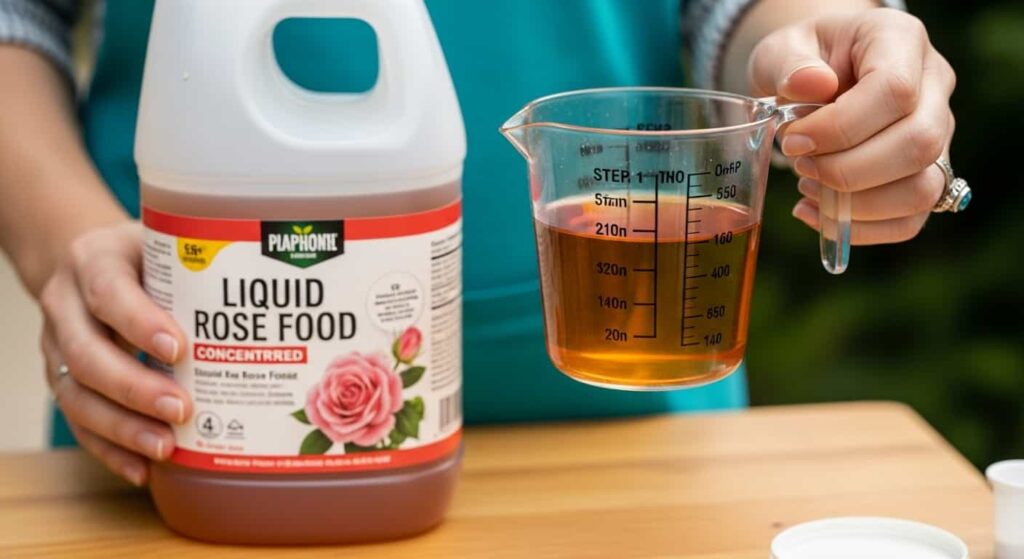
Applying fertilizer correctly is essential to avoid damaging your plant. The most common mistake is applying too much, too often, which leads to “fertilizer burn.”
Step 1: Read the Instructions
Every fertilizer is different. Read the label on your chosen product carefully to understand the recommended dosage and mixing instructions.
Step 2: Dilute, Dilute, Dilute!
For indoor container plants, it is always best to err on the side of caution. A good rule of thumb is to use the fertilizer at half the strength recommended on the package. For example, if the instructions say to mix 1 tablespoon per gallon of water for outdoor plants, use only ½ tablespoon for your indoor rose. A “weakly, weekly” approach (a very diluted solution applied more often) is much safer than a strong dose applied infrequently.
Step 3: Water the Plant First
This is the most important step to prevent root burn. Never fertilize a plant with dry soil. The day before you plan to fertilize, or at least a few hours before, water your rose thoroughly until water runs out the drainage holes. This ensures the roots are hydrated and ready to absorb nutrients without being scorched by direct contact with concentrated fertilizer salts.
Step 4: Apply the Fertilizer Solution
After you have diluted your fertilizer in a separate container, apply it to the moist soil. Pour the solution slowly and evenly over the entire soil surface, just as you would when watering normally. Continue until the solution begins to drain from the bottom of the pot.
Step 5: Discard the Excess
Do not let the pot sit in the runoff that collects in the saucer. After a few minutes, discard any excess liquid from the drainage tray.
Recognizing the Signs of Trouble
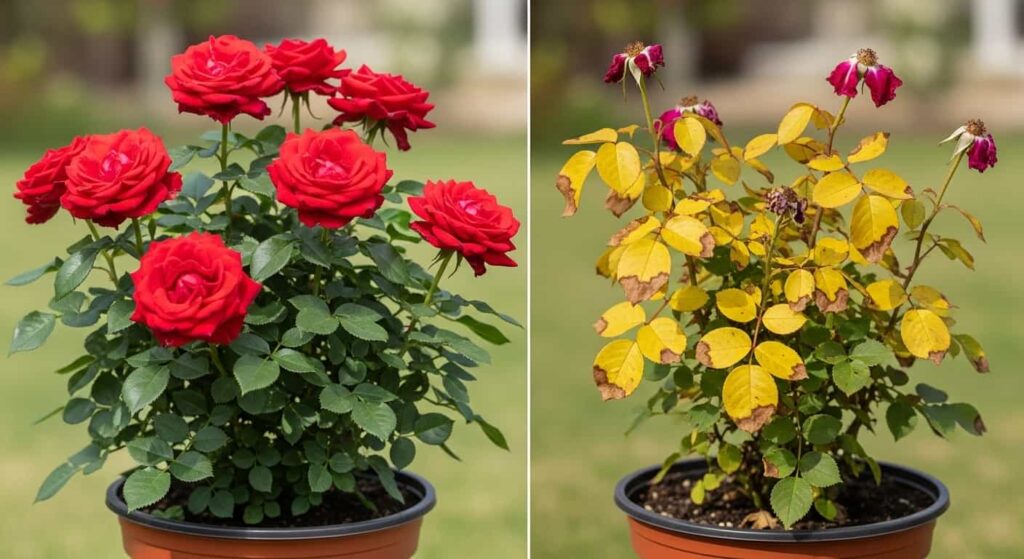
Your plant will give you signals if its nutritional balance is off.
Signs of Under-Fertilizing:
- Yellowing leaves (chlorosis) often start with the lower, older leaves.
- Slow or stunted growth.
- Weak, thin stems.
- Small, pale flowers, or a complete lack of blooms.
Signs of Over-Fertilizing (Fertilizer Burn):
- Brown, crispy leaf edges and tips.
- A white, crusty buildup of mineral salts on the soil surface.
- Sudden leaf drop.
- Wilting or drooping, even when the soil is moist.
- Blackened or burnt-looking roots.
How to Fix Over-Fertilizing: If you suspect you have given your plant too much fertilizer, you need to flush the soil. Take the plant to a sink or bathtub and slowly run a large amount of lukewarm water through the pot. Use a volume of water that is at least four times the volume of the pot. This will help leach the excess fertilizer salts out of the soil. Allow the pot to drain completely, and do not fertilize again for at least a month.
By mastering the simple but crucial art of fertilizing, you provide your indoor roses with the sustained energy they need to perform. A consistent feeding schedule during the growing season will reward you with a vibrant, healthy plant that is capable of producing the magnificent flowers that make roses so beloved.
